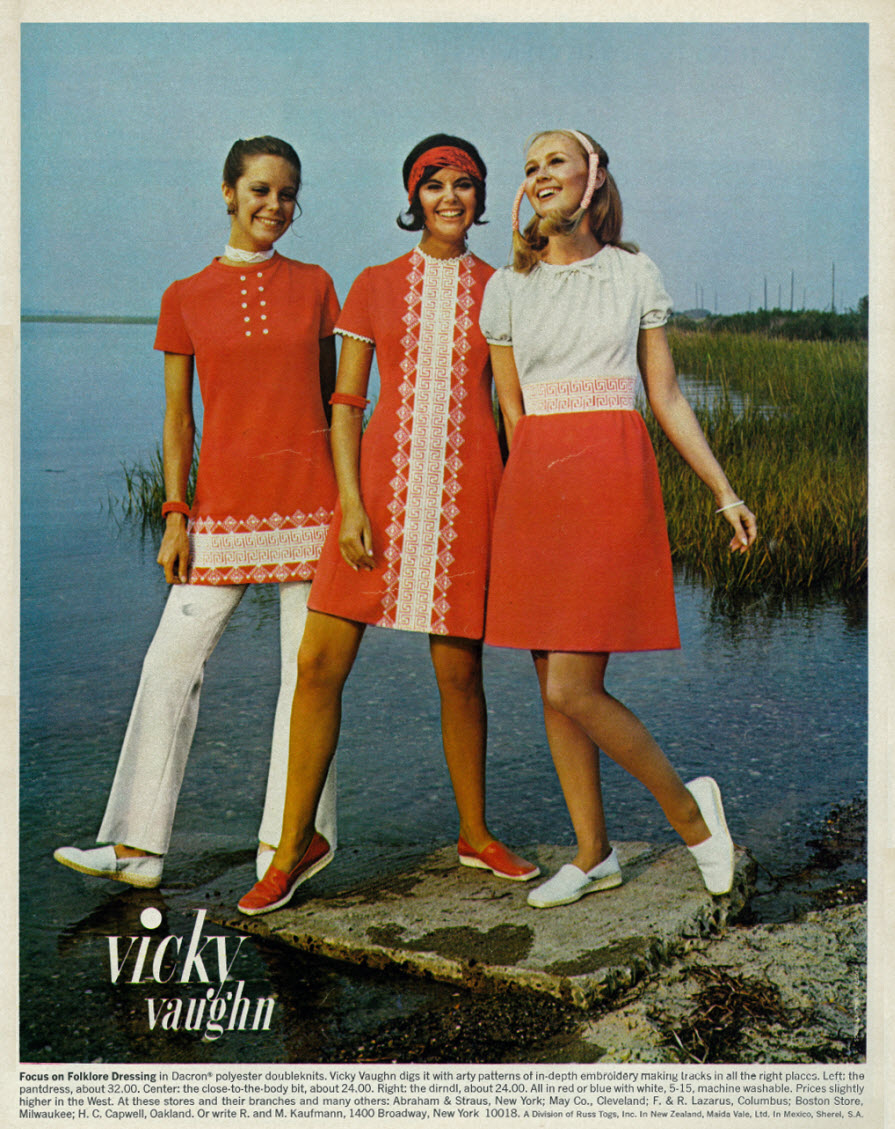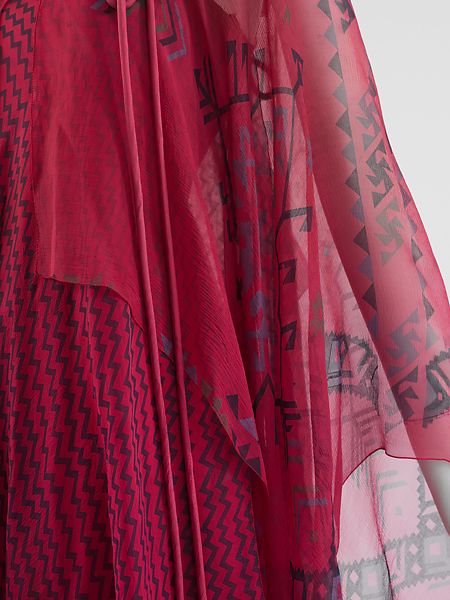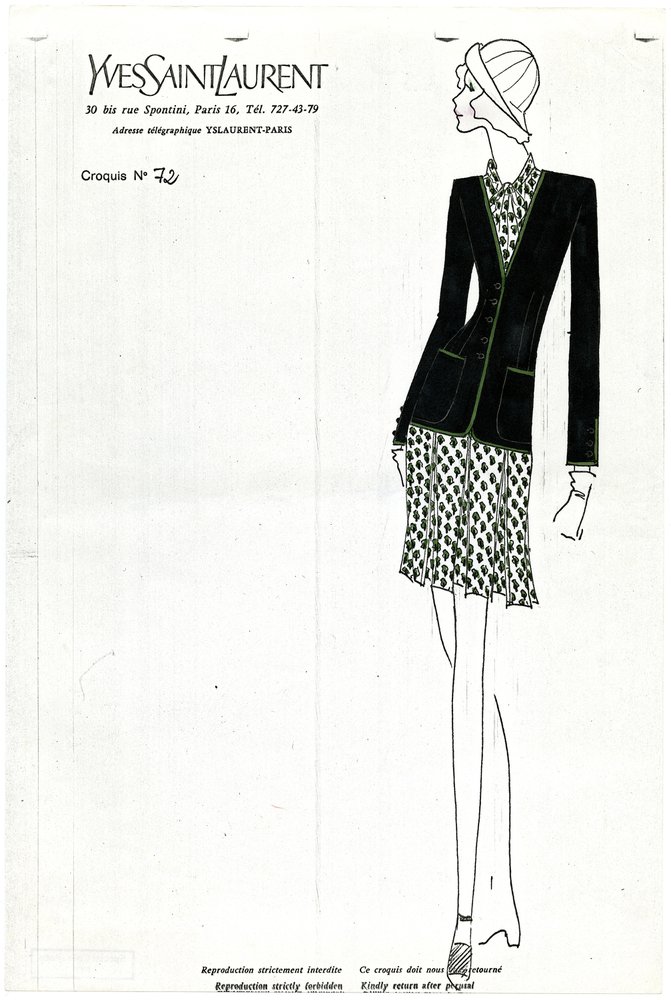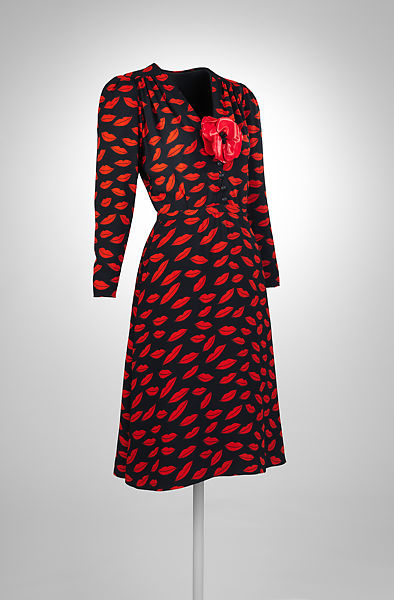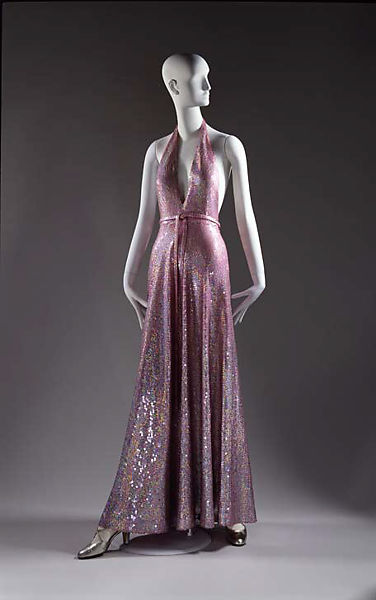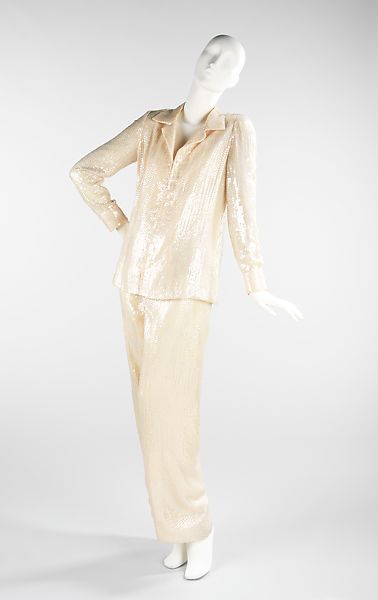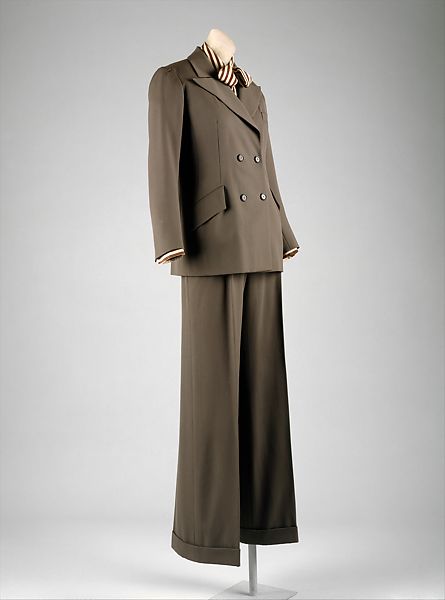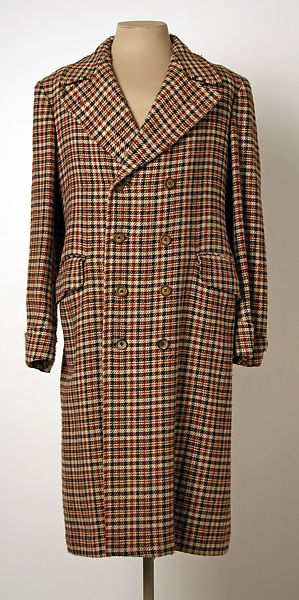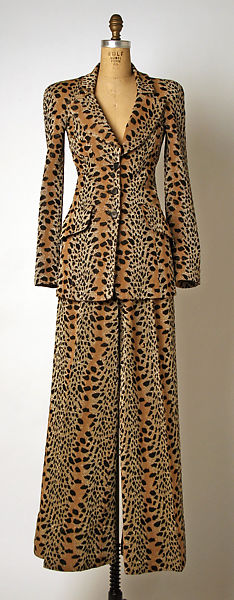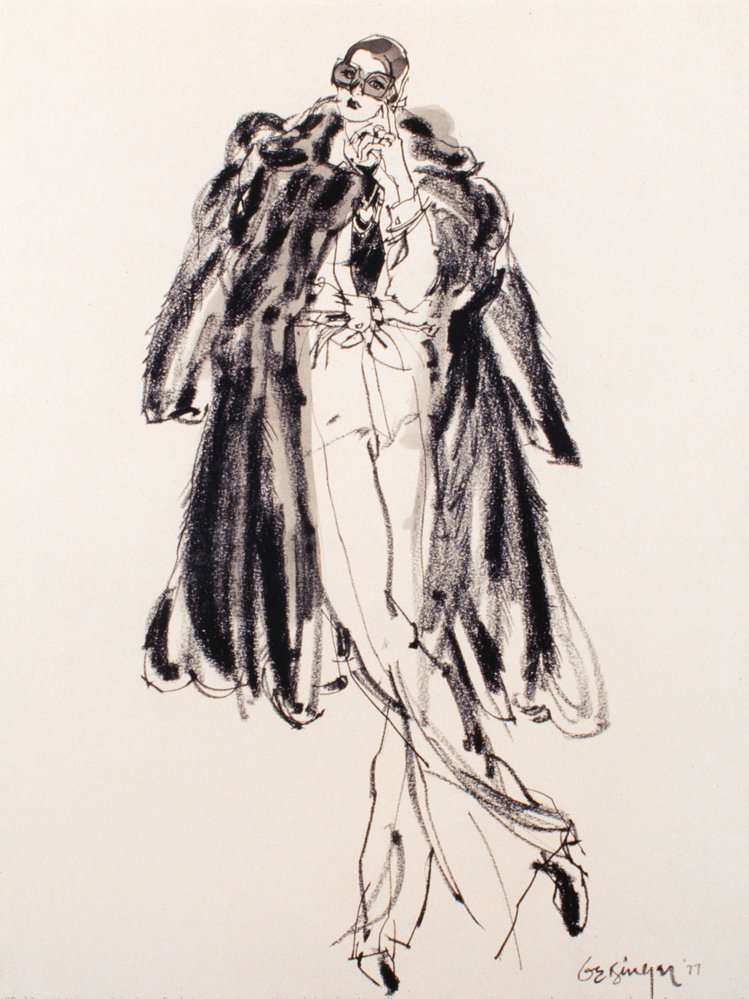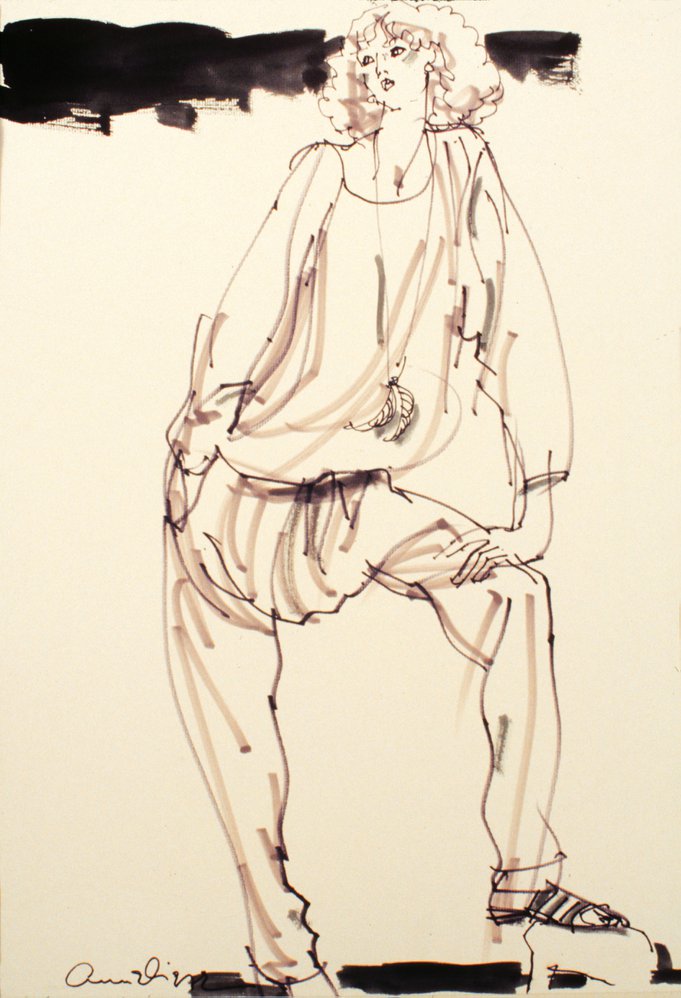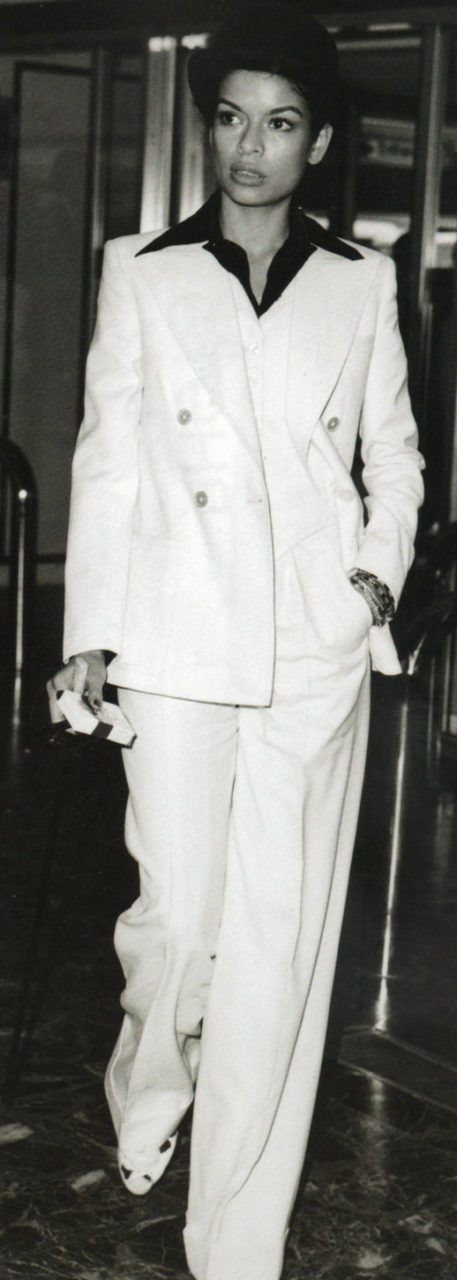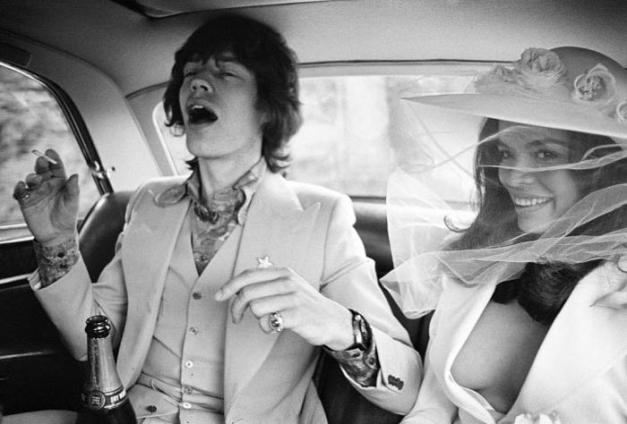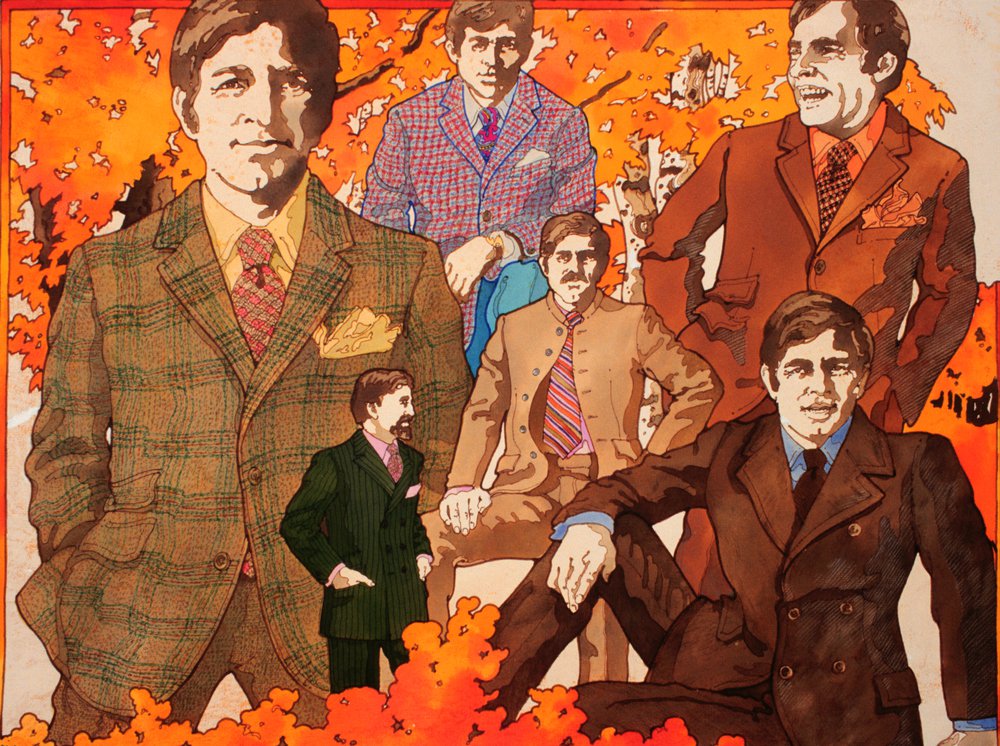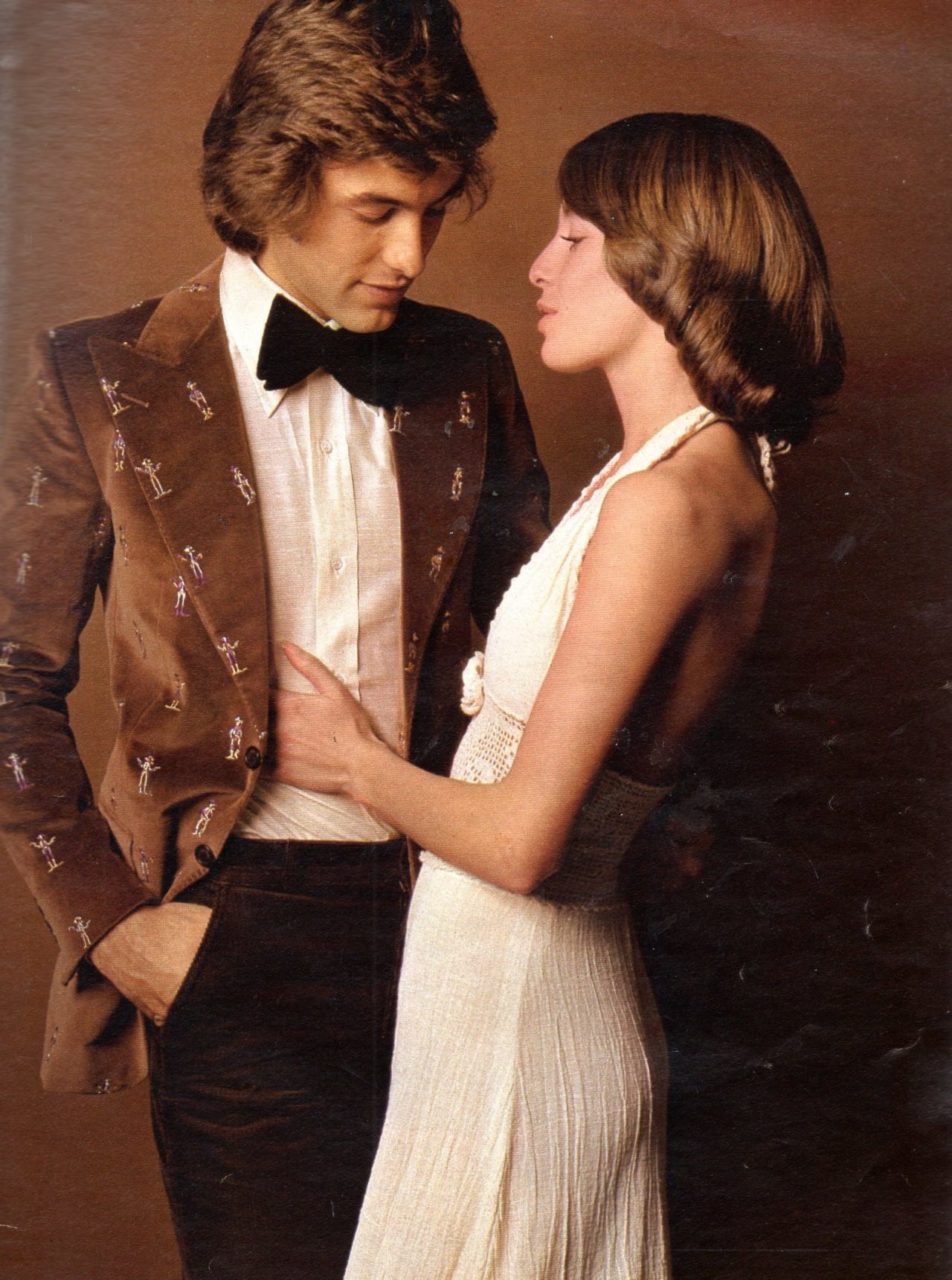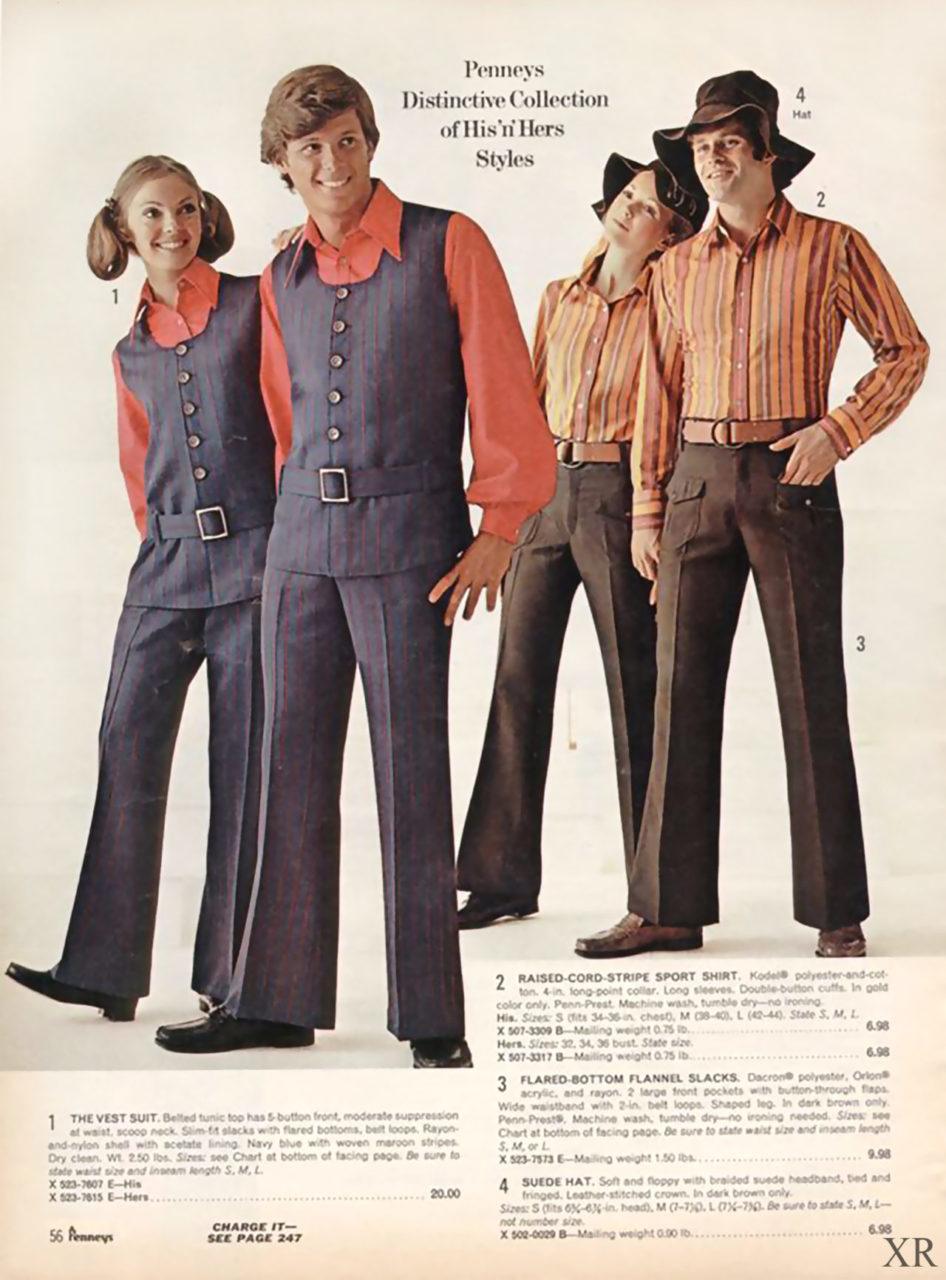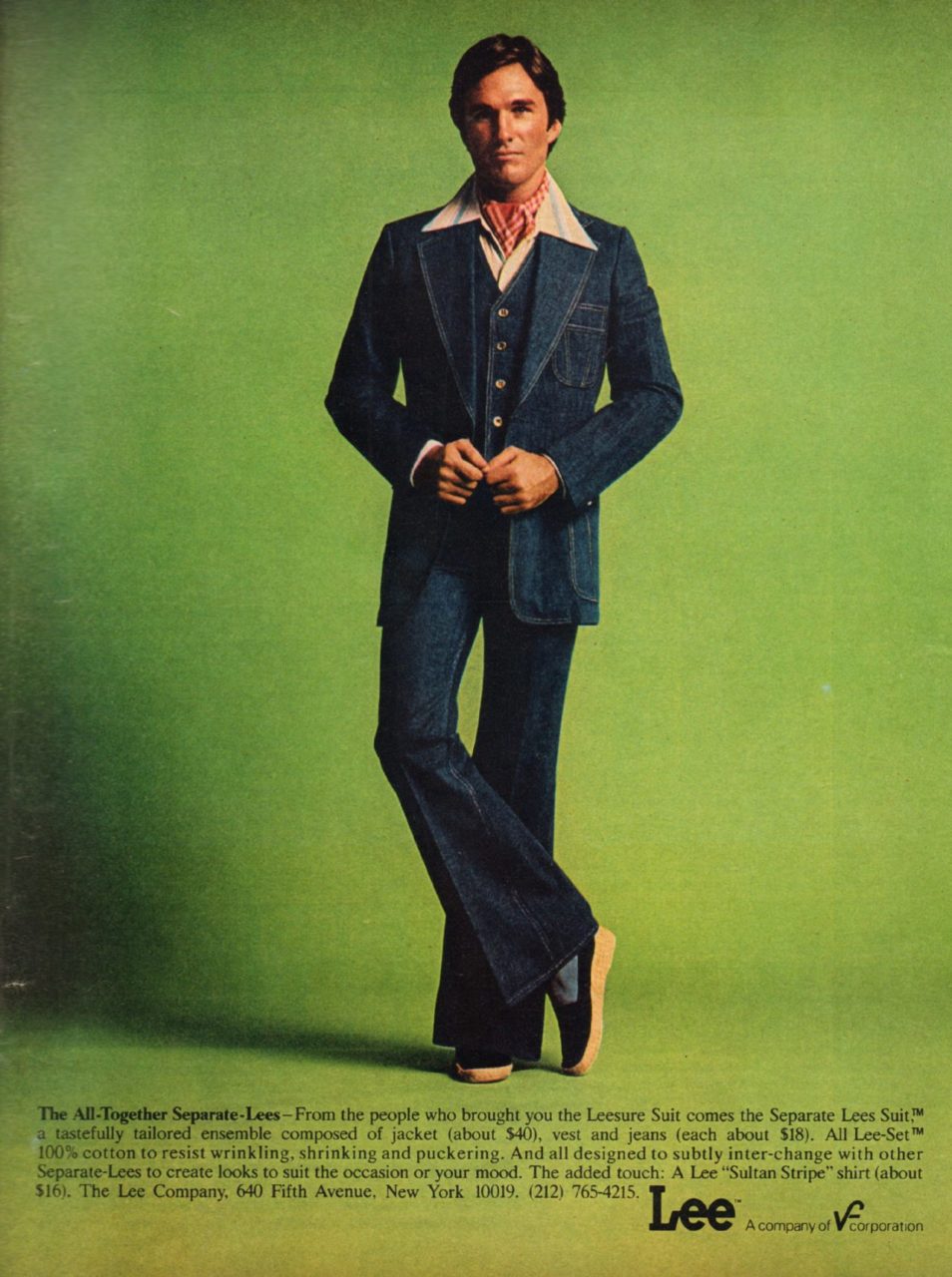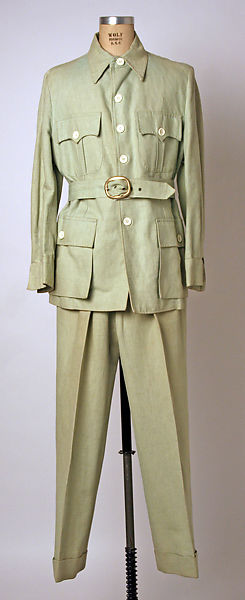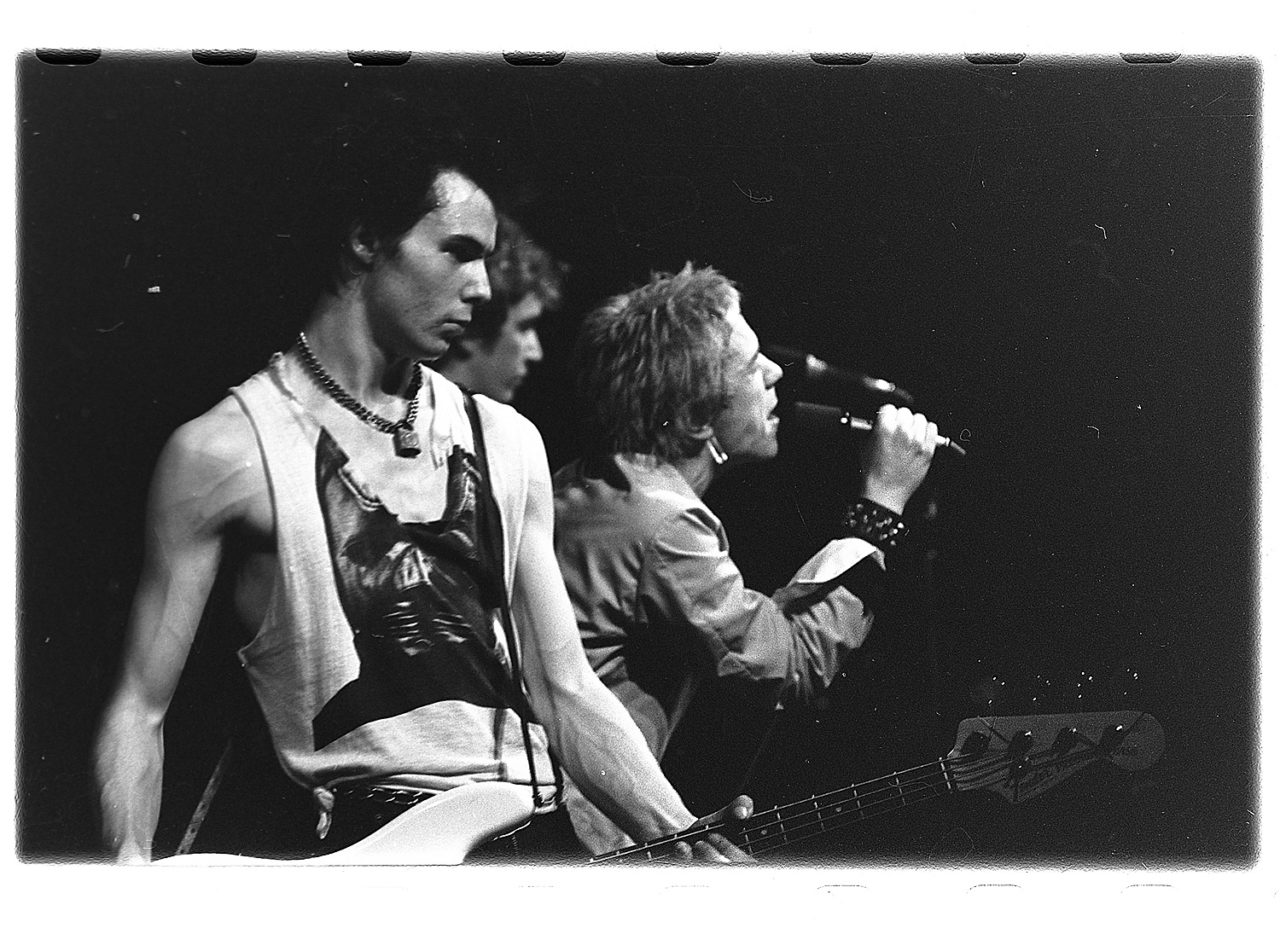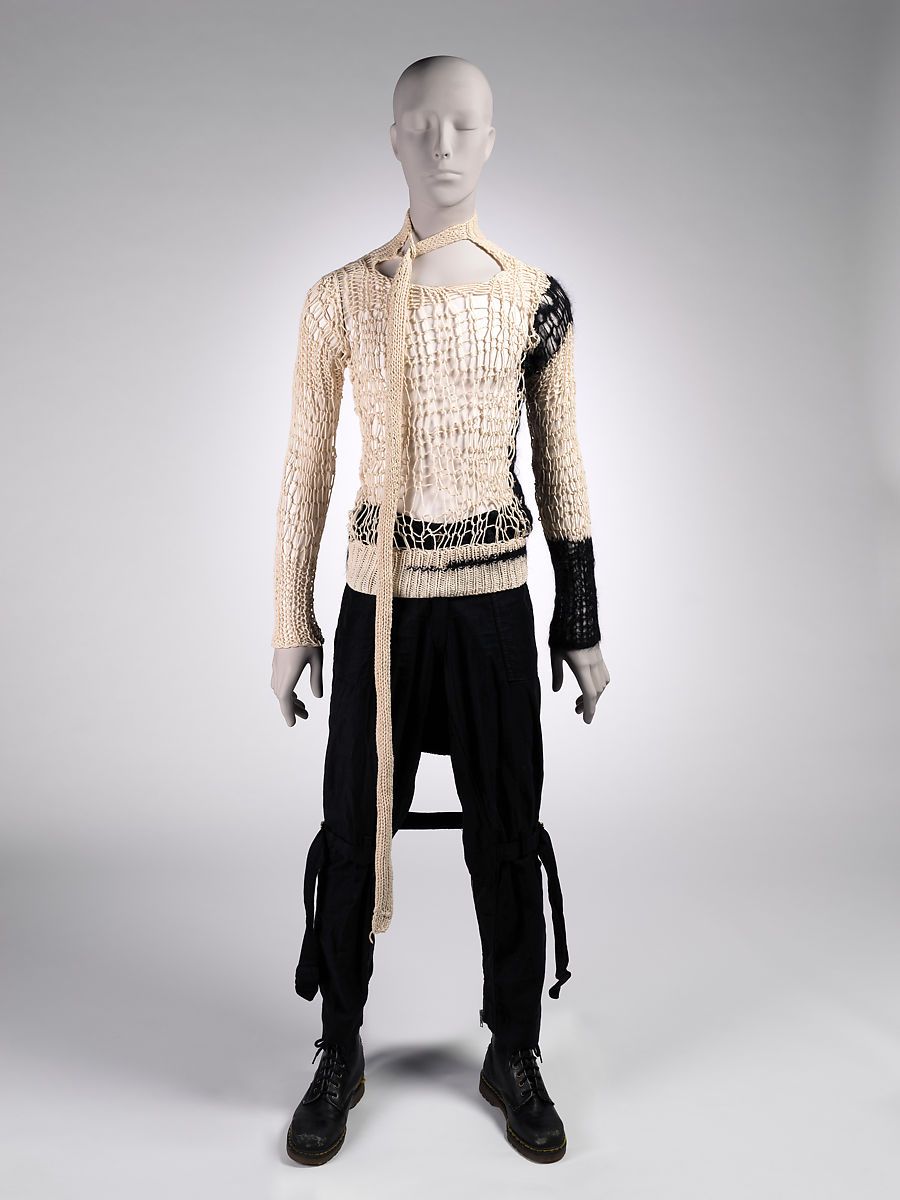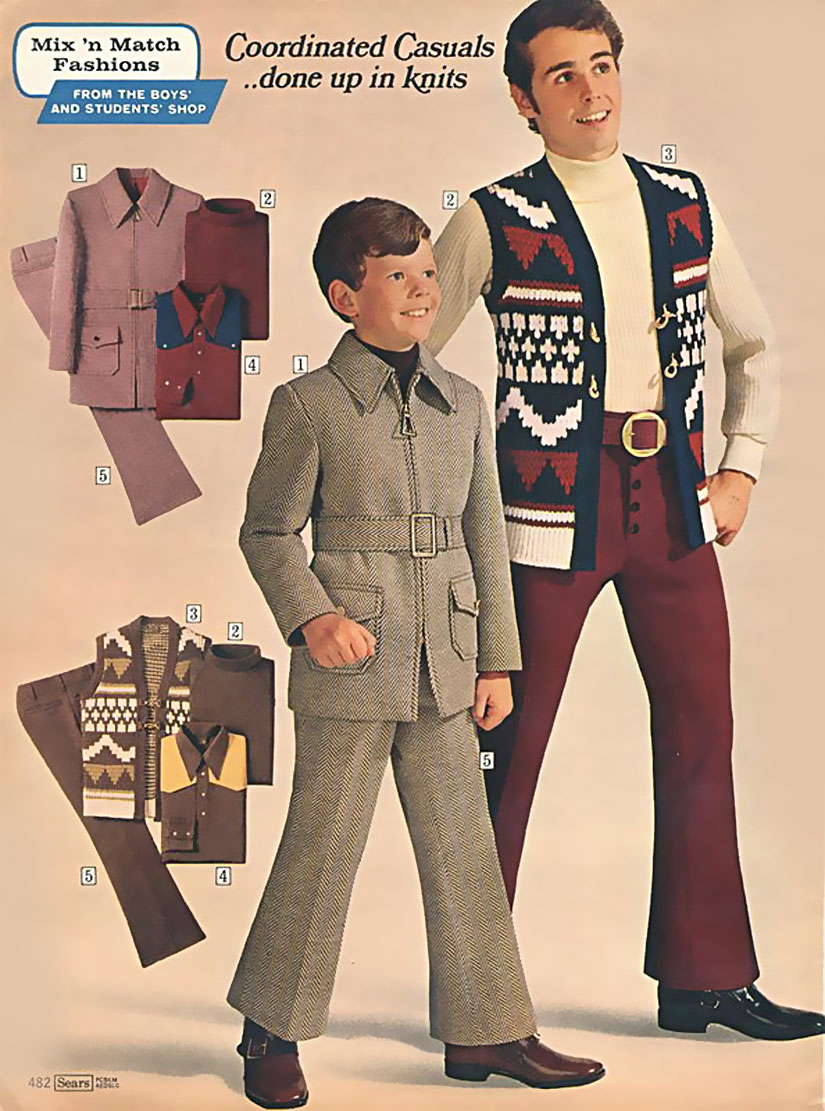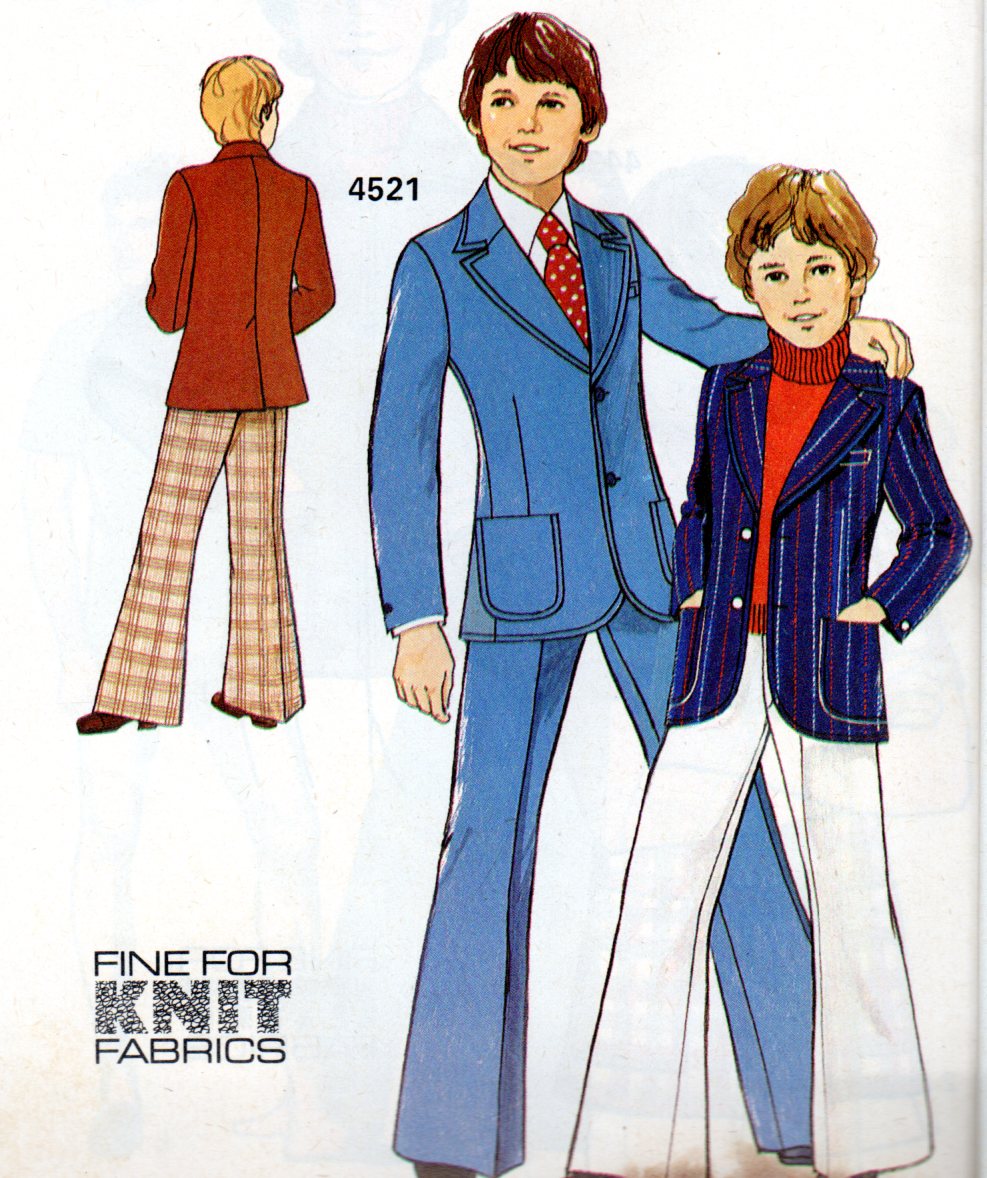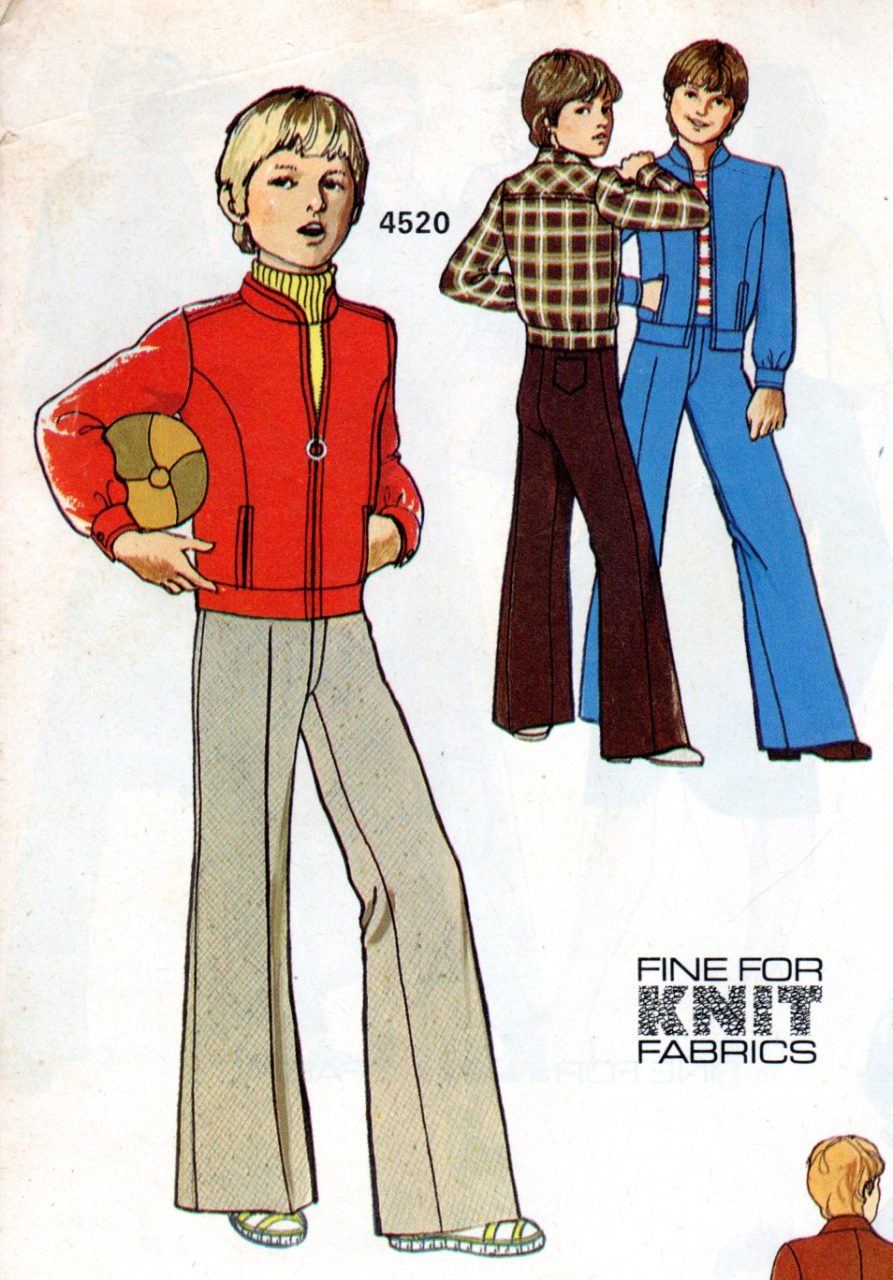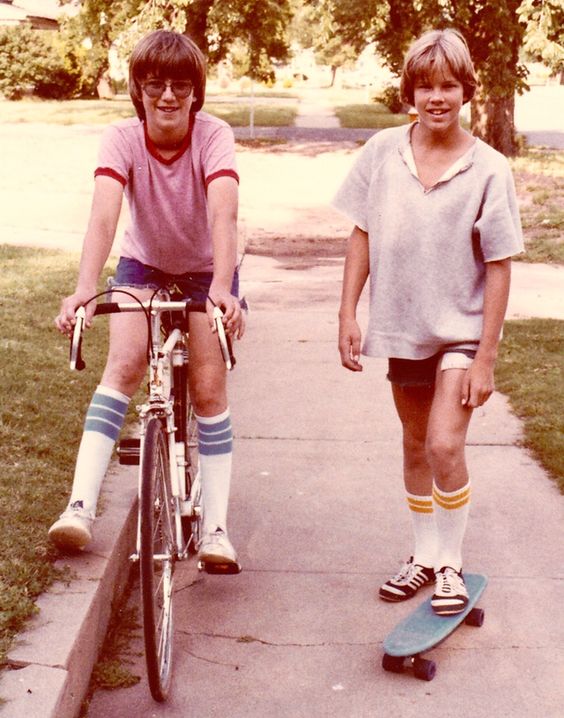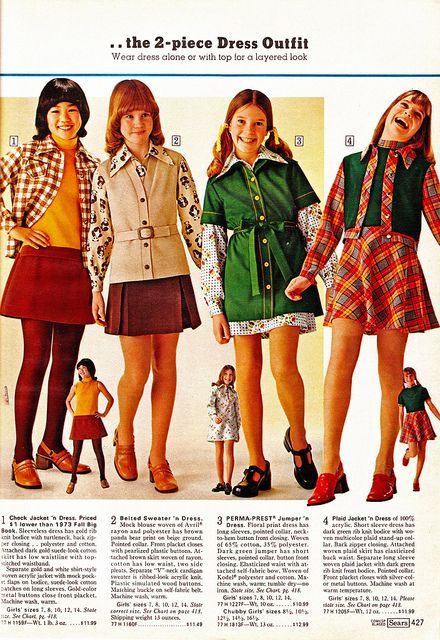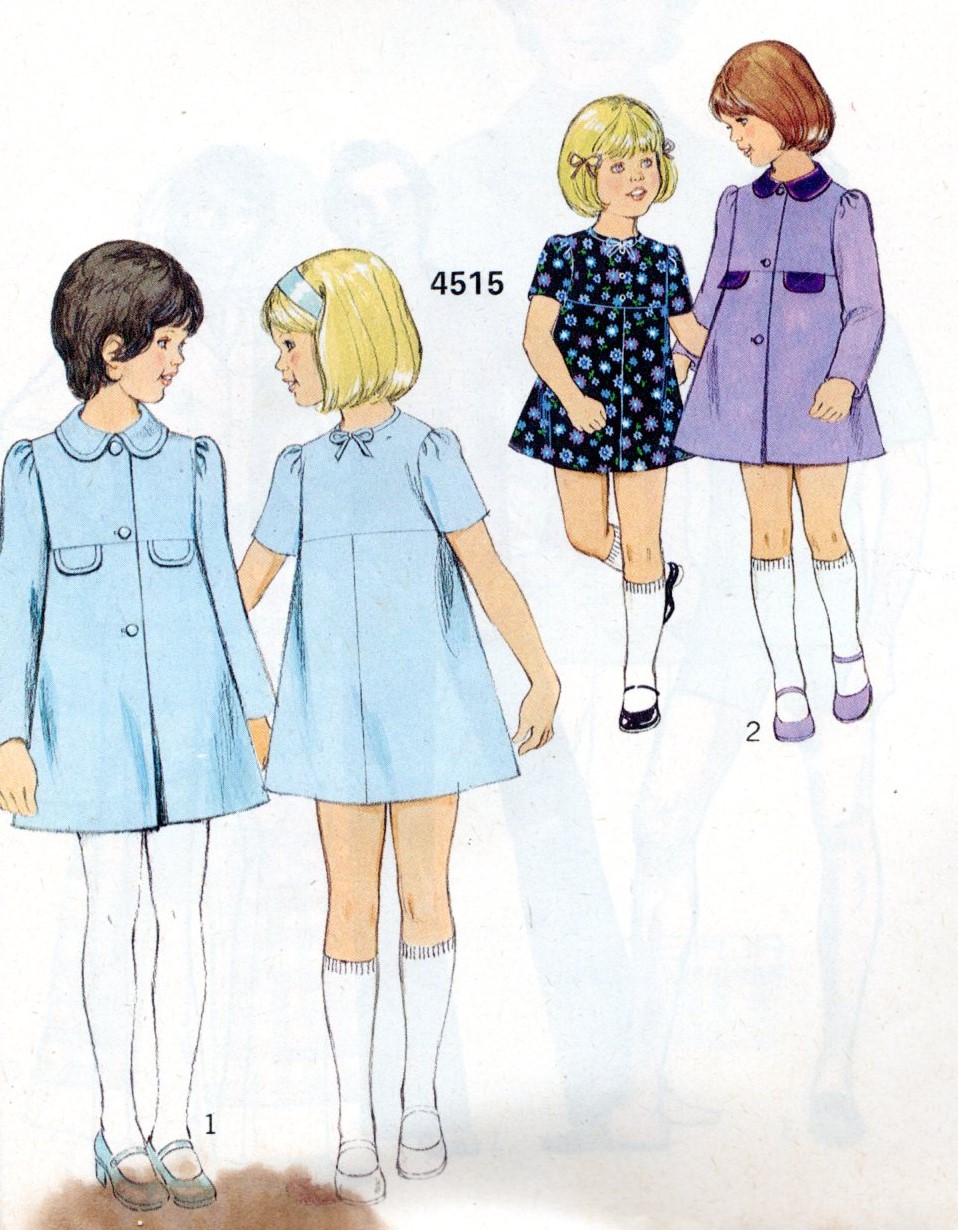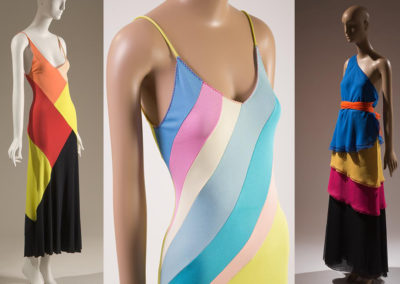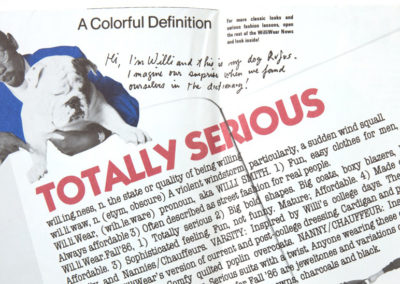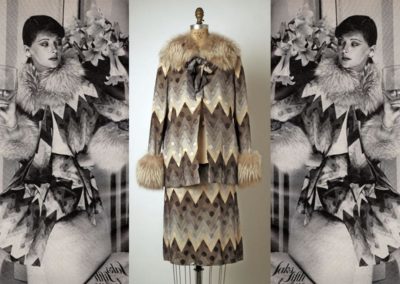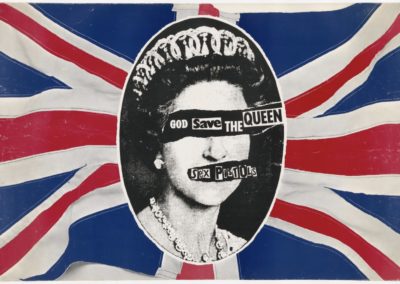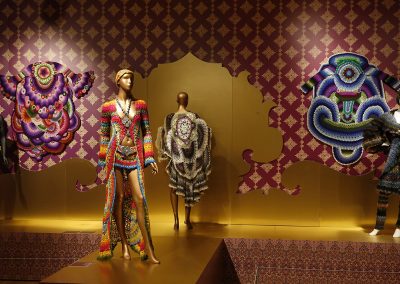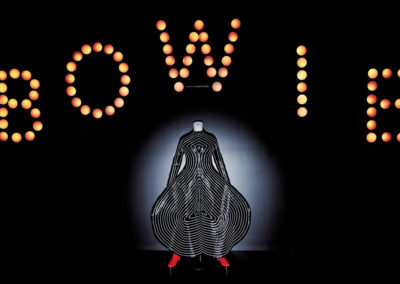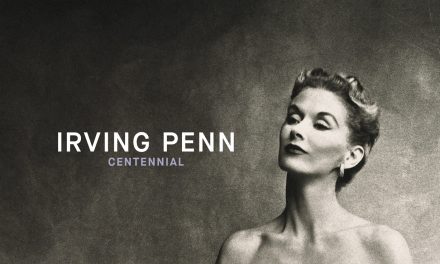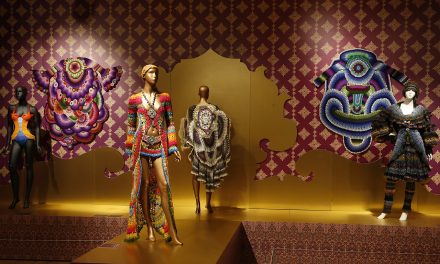OVERVIEW
Seventies fashion saw bold colors and patterns take center stage. Women’s fashion looked back to the 1940s by day and pumped up the glamour by night. Men had an array of suit types to choose from and favored colorful plaids. Children’s fashion followed adult fashion with bold plaids and bright colors with the distinction between genders lessening throughout the decade.
Womenswear
Seventies fashion began with a continuation of the late 1960s hippie style. In the early 1970s, this meant an emphasis on handmade materials and decorations. While the hippies of the sixties had embraced these items as a way of rejecting mainstream fashion, designers in the early seventies began to incorporate them into their high fashion collections. Patchwork, crochet and knitting, embroidery were among the details used by designers. The silk evening gown by Zandra Rhodes shows how patterns and the loose, flowing quality of the hippie style crept into high fashion (Fig. 2). “Quilting, felting, dyeing, beading, smocking, leather craft and hand-painted fabrics were also reclaimed from craft fairs for the fashion world,” says Daniel Milford-Cottam in Fashion in the 1970s (15). The styles from Seventeen magazine show an influence from homemade crafts in the embroidered patterns while being made in the decade’s signature polyester (Fig. 1).
Along with an emphasis on handmade crafts, seventies designers looked to the past for inspiration. A pervasive style of the early 1970s was the prairie dress. Midi-length with flounces and delicate floral patterns, these dresses were popularized by designers and retailers like Gunne Sax and Bill Gibb. The style bore a resemblance to Victorian styles while also feeling not dissimilar to some of the hippie styles of the late 1960s (Fig. 6).
Fig. 1 - Vicky Vaughn. Red & White Folklore Dressing, December 1970. Classic Film. Published in Seventeen magazine, December 1970, Vol. 29 No. 12. Source: Flickr
Fig. 2 - Zandra Rhodes (British, 1940-). Evening dress, 1972. Silk. New York: The Metropolitan Museum of Art, 2003.256.18. Gift of Laura Johnson, 2003. Source: The Metropolitan Museum of Art
Fig. 3 - Yves Saint Laurent (French, 1936-2008). Printed, Handpainted Croquis of A Day dress and Jacket, Summer 1971. Tempera on printed paper. Yves Saint Laurent Sketches. Source: SPARC Digital
Fig. 4 - Halston (American, 1932-1990). Dress, 1972. Ultrasuede. New York: The Metropolitan Museum of Art, 1993.351a, b. Gift of Faye Robson, 1993. Source: The Metropolitan Museum of Art
Fig. 5 - Yves Saint Laurent (French, 1936-2008). Dress, Libération, 1971. Rayon, polyester. New York: The Metropolitan Museum of Art, 2010.364. Purchase, Gould Family Foundation Gift, in memory of Jo Copeland, 2010. Source: The Metropolitan Museum of Art
In the early- to mid-seventies, designers looked to the 1930s and 1940s for inspiration. In 1971, Yves Saint Laurent was especially inspired by 1940s style (Figs. 3, 5). His 1940s-inspired collection, Libération, caused a stir as fashion reporters and other consumers who had been alive during World War II were reminded of the German occupation. Milford-Cottam writes,“They [fashion reporters] reacted with revulsion to the turbans, flirty crêpe dresses and dyed fur boxy jackets that reminded them of Second World War era prostitutes” (29). Though this collection was not necessarily well-received by all, the 1930s and 1940s continued to be a strong influenced on the styles of the 1970s. Other designers also looked to the past in the seventies. The dress by Halston (Fig. 4) is reminiscent of 1950s shirt dresses but made modern with its ultrasuede material.
While daywear looked to the past, evening wear was thoroughly modern. While it may have been known as the “Polyester Decade,” satin, sequins and velvet ruled the dance floor. As disco became increasingly popular, women’s evening wear became increasingly glamorous. The evening dress by Halston is covered in shimmering sequins with a swirling skirt ready for the disco floor (Fig. 7). In the early seventies, women could be seen wearing sequins and hot pants to the disco. Editor Kathryn Hennessy writes of the glamorous styles in Fashion: The Ultimate Book of Fashion and Style:
“Classy, full-length figure-huggers battled with short, sparkly halter necks and hot pants for centre stage. Lycra, satin, and velvet were the fabrics of choice, while feathers and sequins added extra sparkle” (382).
Sparkle and glamour remained ubiquitous throughout the decade and the short minidresses and hot pants earlier in the decade became longer, swirling dresses and skirts in the later part. This change was accompanied by a shift from chunky heels to strappy sandals (Milford-Cottam 47).
Fig. 6 - Seventeen Magazine. "Spring Things", January 1973. Classic Film. Published in Seventeen magazine, January 1973, Vol. 32 No. 1. Source: Flickr
Fig. 7 - Halston (American, 1932-1990). Evening dress, ca. 1974. Cotton, rayon, plastic. New York: The Metropolitan Museum of Art, 1980.586.25. Gift of Jane Holzer, 1980. Source: The Metropolitan Museum of Art
Fig. 8 - Halston (American, 1932-1990). Evening pantsuit, ca. 1971. Silk. New York: Brooklyn Museum Costume Collection at The Metropolitan Museum of Art, 2009.300.969a, b. Gift of the Brooklyn Museum, 2009; Gift of Mildred Custin, 1975. Source: The Metropolitan Museum of Art
Fig. 9 - Yves Saint Laurent (French, 1936-2008). Pantsuit, Spring/summer 1970. Wool. New York: The Metropolitan Museum of Art, 1984.163.4a, b. Gift of Mireille Levy, 1984. Source: The Metropolitan Museum of Art
Fig. 10 - Yves Saint Laurent (French, 1936-2008). Coat, Early 1970s. Wool. New York: The Metropolitan Museum of Art, 1997.190. Gift of Helen and Paul Anbinder,1997. Source: The Metropolitan Museum of Art
Throughout the sixties and seventies, women were gaining increasing sexual freedoms and this was reflected in their clothing. New styles were created and women began to wear clothing heavily inspired by menswear (Figs. 9, 10). In 1974, Bianca Jagger wore a white tuxedo by Halston to Studio 54 (Hennessy 382). The look was not dissimilar to Yves Saint Laurent’s 1966 Le Smoking suit and trousers became increasingly acceptable for both formal wear and work wear. Trouser suits became less form-fitting and feminine (Fig. 8), and Diane Keaton as Annie Hall inspired a trend for layered menswear in 1977 (Milford-Cottam 39-40). This was a shift from the years before when trousers were only seen as acceptable for days spent around the house. New patterns, such as animal print, and accessories like fur coats made them all the more glamorous (Figs. 11, 12).
Another look that reflected women’s sexual freedom was the wrap dress. Producing one of the most famous and popular iterations in 1974, Diane von Fürstenberg sold over five million dresses in just two years (Fig. 13). The dress allowed women to transition from day-to-evening and Von Fürstenberg specifically touted its ability to be taken on and off easily. Milford-Cottam writes,
“With long sleeves and at midi length, wrap dresses offered a professional appearance in the office, and could then be dressed up with strappy sandals, jewelry and loosened hair for an evening on the town immediately after work… Von Fürstenberg openly stated that she designed for the empowered woman seeking a simple little dress that whipped off in an instant, and, more usefully, could be swiftly and silently pulled back on in a dark bedroom without waking last night’s sexual conquest” (46).
As women gained more opportunity to work outside the home, they looked for clothing, like trousers and the wrap dress, that afforded them more freedom. Later in the decade, fashion became even more comfortable. As the 1970s slipped into the 1980s, an emphasis on personal fitness foreshadowed the rise of athletic wear as informal wear (Fig. 14). James Laver writes in Costume and Fashion: A Concise History, “In the late 1970s the American designer Norma Kamali was instrumental in bringing sportswear into the fashion arena, introducing sweat-shirting, ra-ra skirts, bandeau tops, jumpsuits, leotards and leggings” (272). These styles would, of course, come to typify 1980s fashion, but originated in the later years of the seventies.
Fig. 11 - Barbara Hulanicki (British, 1936-). Suit, ca. 1972. Synthetics. New York: The Metropolitan Museum of Art, 1997.59.7a, b. Gift of the Estate of Luciana Martinez de la Rosa, 1997. Source: The Metropolitan Museum of Art
Fig. 12 - Jack Geizinger. Fur Coat and Pantsuit, 1977. Charcoal, wash; (23 in x 16 in). New York: Frances Neady Collection of Original Fashion Illustrations. Source: SPARC Digital
Fig. 13 - Diane von Fürstenberg (American, 1946-). Dress, 1975-76. Cotton/rayon blend. New York: The Metropolitan Museum of Art, 1997.487. Gift of Richard Martin, 1997. Source: The Metropolitan Museum of Art
Fig. 14 - Annaliese Kapp. Tunic and pants, 1970s. Marker, wash; (24 in x 16 in). New York: Frances Neady Collection of Original Fashion Illustrations. Source: SPARC Digital
Fashion Icons: Bianca and Mick Jagger
Though their marriage only lasted until 1978, both Mick and Bianca continued to be stalwarts of rock and glamour throughout the decade. Mick’s long hair and rock-star lifestyle became the stuff of legend, while Bianca became friends with stars of the fashion and pop worlds such as Halston and Andy Warhol (Fig. 17). Further cementing her status as a glamour icon, her name became synonymous with Studio 54, the famous New York nightclub. Here, she wore sequins and skin-tight silk dresses, and created some of the most iconic fashion moments of the 1970s.
In 1974, she wore a white satin trouser suit by Halston, not dissimilar to the white suit in figure 15 (probably Yves Saint Laurent) and on her thirtieth birthday in 1977, she was pictured in a red off-the-shoulder dress on top of a white horse in the nightclub. Her impact on fashion has endured with her name being synonymous with 1970s glamour and she is often cited as a fashion muse by designers today.
Fig. 15 - Photographer unknown. Bianca Jagger, 1972. Laura Loveday. Source: Flickr
Fig. 16 - Photographer unknown. Mick Jagger and Bianca Perez Morena de Marcias just after their wedding in St Tropez, France, May 1971. Kristine. Source: Flickr
Fig. 17 - Alberto Botella. Bianca Jagger Andy Warhol, 1970s. Alberto Botella. Source: Flickr
Menswear
In the early 1970s, men’s fashion tried to emphasize a tall, lean figure. Turtlenecks, slim-fitting shirts, and tight-fitting flared pants all worked to popularize the silhouette. Milford-Cottam writes,
“Wide belts with large buckles focused the eye on the centre of the torso, making broader bodies appear slimmer. Over the top, a sleeveless waistcoat or jerkin, a classic single-breasted sports jacket in tweed, denim, or corduroy, or a blouson jacket in leather or synthetic fabric was usually worn” (37).
Shirts and trousers were tighter than they’d ever been and the long hair popularized by the hippies in the late 1960s continued to be widespread.
Just as womenswear embraced elements of menswear, men’s fashion also became more gender-neutral in the 1970s (Fig. 21). “Fashion had reached a new level of gender equality, particularly in informal wear,” says Milfrod-Cottam (40). Tight t-shirts, jeans, shirts and sweaters were worn by both men and women and some skinny men even opted to wear women’s clothing instead of men’s.
Fig. 18 - Norman Green. Men's Suit Jackets, 1970s. Marker, watercolor. New York. Frances Neady Collection of Original Fashion Illustrations. Source: SPARC Digital
Fig. 19 - Jours de France. Jours de France Fashion, 1974. Mo. Source: Flickr
Fig. 20 - Photographer unknown. All Made to Mix, 1970. James Vaughan. Source: Flickr
Fig. 21 - Penneys. Distinctive Collection of His'n'Hers Styles, 1970s. James Vaughan. Source: Flickr
Fig. 22 - Lee. The All-Together Separate-Lees, May 1976. SenseiAlan. Playboy Magazine. Source: Flickr
Though more informal looks were increasingly acceptable, suits were still required by many. The traditional suit reflected the prevailing styles with slim-fitting jackets and flared trousers, often with wide lapels. However, while suits and tuxes were still required, they also came in new materials like patterned velvet (Fig. 19).
However, there were new varieties that provided less formal versions. All materials were utilized, resulting in plaid and denim suits (Fig. 20, 22). The safari suit (Fig. 23), popularized by Roger Moore as James Bond, was a popular option in the summer. The light-colored suit was worn belted and had large patch-pockets. It came many variations of long- or short-sleeves and pants or shorts. It was an alternative to the suit for slightly less formal occasions.
Similarly, the leisure suit was a less formal option. These suits were made in lightweight fabrics and came in pastel colors. However, while the safari suit was seen on the suave James Bond, the leisure suit was often made of synthetic fabrics and seen as a cheap alternative: “As leisure suits were often perceived as being poorer quality, cheaper and made in obviously synthetic fabrics, they became considered somewhat vulgar, or at best comical” (Milford-Cottam 38).
As the decade progressed, the dominant silhouette for menswear began to widen again. Milford-Cottam writes, “Towards the end of the decade, double-breasted suits with wider shoulders and narrower legs and lapels began to come into fashion” (38). Just as womenswear would see shoulders widen in the 1980s, men’s suits also saw shoulders widen as the 1970s inched towards the eighties.
Fig. 23 - Pierre Cardin (French, 1922-). Leisure Suit, 1974. Linen. New York: The Metropolitan Museum of Art, 1982.276.1a–c. Gift of Edward Villiotti, 1982. Source: The Metropolitan Museum of Art
Fig. 24 - Billedbladet NÅ/Arne S. Nielsen (Norwegian). The Sex Pistols (Sid Vicious left, Steve Jones center, and Johnny Rotten right) performing in Trondheim, 1977. Riksarkivet (National Archives of Norway). Source: Flickr
Fig. 25 - Photographer unknown. Bob Marley live in concert in Zurich, Switzerland at the Hallenstadium, May 30, 1980. Source: Wikipedia
In the mid-1970s, some men and women in London began to shock with the anarchic Punk style. This style spread somewhat throughout Europe and North America, but its bedrock was in London and the UK with Vivienne Westwood and Malcolm McLaren spreading the style, like those in figure 26, with their shop Seditionaries. The style consisted of tight black pants, leather jackets and Doctor Marten boots. Laver writes of the Punk style, “Clothes were slashed and ripped, embellished with safety pins, zips and studs. T-shirts were printed with aggressive anarchistic slogans” (271). British band The Sex Pistols were a high profile Punk band that helped to popularize the style as fans ripped their clothing and created their own homemade version of the clothes seen on the band (Milford-Cottam 7, Fig. 24).
Just as womenswear saw a rise in athletic wear as leisurewear, so too did menswear. Tracksuits and running shoes were worn as every day casual wear. Bob Marley was an early adopter of this style, wearing tracksuits and soccer jerseys on stage for his concerts (Laver 272, Fig. 25). While tennis and golf clothes had long been acceptable casual wear, it wasn’t until the 1970s that more athletic-looking styles were seen as everyday fashion.
Fig. 26 - Malcolm McLaren Vivienne Westwood (British, 1941-, 1946-2010). Sweater, 1978. Wool. New York: The Metropolitan Museum of Art, 2018.805. Purchase, Friends of The Costume Institute Gifts, 2018. Source: The Metropolitan Museum of Art
CHILDREN’S WEAR
Throughout the seventies, boys wore brightly colored and flared trousers (Fig. 28). In the early 1970s, boys’ trousers came in bright colors and bold patterns. Plaids and stripes were especially popular and many had matching vests, often belted (Fig. 27). These elements were worn with brightly colored button-down shirts and sometimes with a matching jacket. The polyester leisure suit, popular among some men in the seventies, was also worn by young boys.
Later in the decade, styles became more informal (Fig. 29). Screen-printed t-shirts and raglan shirts reflected trends in popular culture in the later part of the decade. Denim jackets and collared knit shirts were a good alternative to the more formal styles earlier in the seventies. Sportswear also became a popular everyday casual style (Fig. 30). While bold colors and patterns were still present in the later years, they were slightly more muted and styles began to shift towards the preppy look of the 1980s towards the end of the decade.
Fig. 27 - Photographer unknown. Coordinated Casuals, 1971. James Vaughan. Source: Flickr
Fig. 28 - Artist unknown. Fine for Knit Fabrics, 1974. Mo. Source: Flickr
Fig. 29 - Artist unknown. Fine for Knit Fabrics, 1974. Mo. Source: Flickr
Fig. 30 - Photographer unknown. Unknown, 1970s. Source: Pinterest
Girls also wore bright, flared trousers throughout the seventies. While pants were increasingly acceptable for girls, many still opted to wear dresses and skirts. These also came in bright colors and patterns, with bold plaids, florals and paisleys popular options (Fig. 31). Unlike womenswear, young girls continued to wear minidresses and skirts in the early part of the decade (Fig. 32, 33). These came in clashing color combinations and had Victorian accents such as frilled collars and sleeves. As the decade progressed, girls started to wear longer dresses and skirts, following women’s fashion.
In the mid- to late-seventies, a popular look for young girls were overalls (with flared pant legs, of course). These came in bright colors or patterns and were often worn with frilly blouses underneath (Fig. 34). Matching pant sets were also popular and in the latest part of the decade, trousers began to be less flared. Girls’ blouses and dresses began to see a strong Victorian influence like those of women’s prairie dresses. By 1979, midi-length skirts began to dominate and the overall shape became boxier as girls’ fashion welcomed the 1980s.
Fig. 31 - Artist unknown. The 2-Piece dress Outfit, 1970s. Source: Pinterest
Fig. 32 - Artist unknown. Child's Coat and dress, 1974. Mo. Source: Flickr
Fig. 33 - Chez Nous. Unknown, 1970. Mo. Source: Flickr
Fig. 34 - Artist unknown. Girls' pinafore dress in two lengths, dungarees and blouse, 1974. Mo. Source: Flickr
References:
- Callahan, Colleen R. “History of Children’s Clothing.” LoveToKnow. Accessed August 31, 2019. https://fashion-history.lovetoknow.com/fashion-history-eras/history-childrens-clothing.
- The Guardian. “Bianca Jagger: ‘I did not ride the horse into Studio 54. I just got on it.’” Accessed August 31, 2019. https://www.theguardian.com/music/2015/apr/25/bianca-jagger-i-did-not-ride-the-horse-into-studio-54-i-just-got-on-it.
- Hennessey, Kathryn. Fashion: The Ultimate Book of Costume and Style. London: Dorling Kindersley, 2012. http://www.worldcat.org/oclc/816318024.
- Khomo, Delilah. “Mick and Bianca Jagger’s Wedding, 1971.” Porter, May 20, 2018. Accessed August 31, 2019. https://www.net-a-porter.com/gb/en/porter/article-171576303d5e0be5/lifestyle/travel/bianca-jagger-wedding-outfit.
- Laver, James, Amy De La Haye and Andrew Tucker. Costume and Fashion: A Concise History. 5th ed. New York: Thames & Hudson, 2012. http://www.worldcat.org/oclc/966352776.
- Milford-Cottam, Daniel. Fashion in the 1970s. Oxford: Shire Publishing, 2018. http://www.worldcat.org/oclc/1099803562.
- The People History. “Seventies Children’s Fashion Clothes.” Accessed August 31, 2019. http://www.thepeoplehistory.com/1970skidsfashion.html.
- Roiz, Jessica Lucia. “Happy Birthday Bianca Jagger: 20 Things About Nicaraguan Activist, Mick Jagger First Wife.” Latin Times, May 2, 2016. Accessed August 31, 2019. https://www.latintimes.com/happy-birthday-bianca-jagger-20-things-about-nicaraguan-activist-mick-jagger-first-383278.
- Scott, Nick. “Let’s Spend Some Life Together: Mick & Bianca Jagger.” The Rake, July 2016. Accessed August 31, 2019. https://therake.com/stories/icons/lets-spend-life-together-mick-bianca-jagger/.
- Victoria and Albert Museum. “History of Fashion, 1900 – 1970.” Accessed August 31, 2019. http://www.vam.ac.uk/content/articles/h/history-of-fashion-1900-1970/.
- Victoria and Albert Museum. “Introduction to 20th-Century Fashion.” Accessed August 31, 2019. http://www.vam.ac.uk/content/articles/i/introduction-to-20th-century-fashion/.
Historical Context
Wikipedia: 1970-1979
Events:
- 1971 – Halston, considered by American socialites as the best evening wear designer, is given the “Winnie” (women’s wear award) at the Coty American Fashion Critics’ Awards.
- 1972 – Japanese designer Kansai Yamamoto designs costumes for David Bowie’s Ziggy Stardust tour. British designer Bill Gibb holds his debut fashion show at the Oriental Club, London. His romantic clothes include printed leather skirts and colorful knits.
- 1975 – Italian designer Giorgio Armani founds his own label. London punk band the Sex Pistols play their first gig at Saint Martin’s College of Art.
- 1976 – The comedy crime drama Charlie’s Angels makes its debut on US television. The three female leads are celebrated for their hairstyles and individual fashion choices.
- 1977 – Ralph Lauren styles Diane Keaton’s wardrobe in Woody Allen’s film Annie Hall, launching numerous copycat looks of baggy linen pants and crisp white shirts and ties for women.
- 1978 – Perry Ellis founds his own line, showing American sportswear, clothes with loose tailoring, long lines, and oversized sweaters.
Timeline Entries
Primary/Period Sources
Resources for Fashion History Research
To discover primary/period sources, explore the categories below.
Have a primary source to suggest? Or a newly digitized periodical/book to announce? Contact us!
Periodicals (Digitized)
Filmography
Secondary Sources
Also see the 20th-century overview page for more research sources... or browse our Zotero library.


